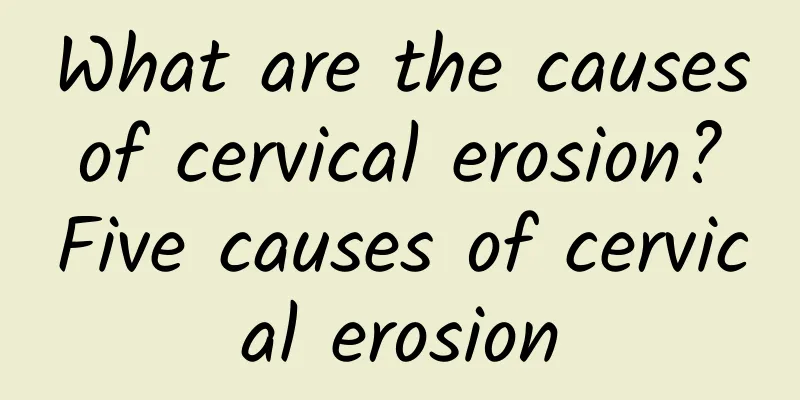Why do I still get uterine fibroids after menopause? Why do uterine fibroids still grow after menopause?

|
Why do menopausal women still get uterine fibroids: Exploring the causes of postmenopausal uterine fibroids Menopause refers to the process of stopping menstruation at a certain age (usually 45-55 years old) in women. Due to the decline of ovarian function, changes in hormone levels, and no longer ovulation, it is confusing that some women still suffer from uterine fibroids after menopause, which makes people wonder why menopausal women still have uterine fibroids. 1. Association with changes in hormone levels After menopause, the levels of estrogen and progesterone in a woman's body decrease. However, even after menopause, a woman's body still has some degree of hormonal activity. Uterine fibroids are composed of smooth muscle in the endometrium, and estrogen is the main driver of their growth and proliferation. Even after menopause, trace amounts of estrogen are still present in a woman's body, which may stimulate the growth of uterine fibroids and cause them to continue to exist. 2. Latent and aggravated uterine fibroids In many women, uterine fibroids may already exist before menopause but without obvious symptoms. These latent uterine fibroids are likely to get a chance to develop and worsen after menopause. After menopause, estrogen levels drop and uterine fibroids may be suppressed, but insufficient cell tissue may cause them to worsen again. This explains why some women still experience symptoms of uterine fibroids after menopause. 3. Heredity and gene mutation Genetic factors play an important role in the development of uterine fibroids. Some studies have found that people in high-risk families have a higher risk of developing uterine fibroids after menopause. In addition, gene mutations are also thought to be involved in the development of uterine fibroids. These gene mutations may make uterine fibroids more sensitive to estrogen, leading to continued growth and development after menopause. Conclusion: Why uterine fibroids still occur after menopause is a complex issue. Hormone level changes, previous latent fibroids, and genetic factors may explain this phenomenon. After menopause, women should have regular gynecological examinations to detect and manage uterine fibroids in a timely manner. Further research will help to gain a deeper understanding of why uterine fibroids still occur after menopause and find more effective prevention and treatment methods. Keywords appearing in the article: 1. Title: Why do menopausal women still get uterine fibroids? 2.1: After menopause, the levels of estrogen and progesterone in women's bodies decrease. However, even after menopause, a certain degree of hormonal activity still exists in women's bodies. Uterine fibroids are composed of smooth muscle in the endometrium, and estrogen is the main driver of their growth and proliferation. Even after menopause, trace amounts of estrogen still exist in women's bodies, which may stimulate the growth of uterine fibroids and cause them to continue to exist. 3.2: In many women, uterine fibroids may already exist before menopause but without obvious symptoms. These latent uterine fibroids are likely to get a chance to develop and worsen after menopause. After menopause, estrogen levels drop and uterine fibroids may be suppressed, but insufficient cell tissue may cause them to worsen again. This explains why some women still experience symptoms of uterine fibroids after menopause. 4.3: Genetic factors play an important role in the development of uterine fibroids. Some studies have found that high-risk families have a higher risk of developing uterine fibroids after menopause. In addition, gene mutations are also considered to be possibly related to the development of uterine fibroids. These gene mutations may make uterine fibroids more sensitive to estrogen, leading to continued growth and development after menopause. |
Recommend
Symptoms of patients with vulvar leukoplakia
Vulvar leukoplakia is a common gynecological dise...
Women should try to master the conditioning methods of cervical erosion
Nowadays, more and more women suffer from cervica...
Vaginitis can present different symptoms in different types
Vaginitis can present different symptoms in diffe...
Common causes of irregular menstruation
Irregular menstruation mainly refers to an abnorm...
Regular rope skipping can help prevent ectopic pregnancy
People often say: "Life lies in exercise.&qu...
Lose weight without starving! Homemade Beetroot and Apple Salad
Because of the rule of "taking medicine afte...
Several causes of vulvar leukoplakia that need attention
Vulvar leukoplakia is a gynecological disease tha...
Good methods should be used to care for patients with cervical hypertrophy
The frequent occurrence of cervical hypertrophy w...
How to prevent cervical warts in women
Cervical warts are a common type of sexually tran...
People with high body fat, "puff tribe", beware of the new three highs
Are you a "puff person" with high body ...
Can ectopic pregnancy cause infertility? What should I check for infertility?
Infertility is a big blow to newlyweds. Women sho...
Can I eat melon seeds after a miscarriage? Be careful about the amount
Melon seeds and peanuts are dried fruits that we ...
Can I have children if I have cervical warts?
Cervical warts are a contagious disease, so befor...
Vulvar itching, leucorrhea, abnormal odor
Vulvar itching, abnormal vaginal discharge, and o...
What to eat when leucorrhea smells bad
Abnormally foul-smelling leucorrhea may be relate...









